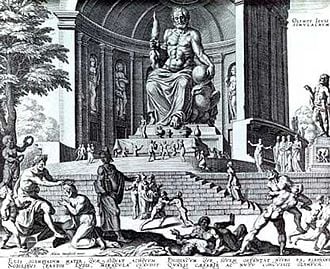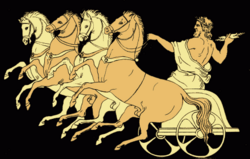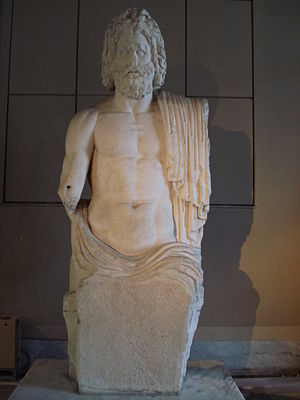Zeus

Phidias created the 12-meter-tall statue of Zeus at Olympia about 435 B.C.E. The statue was perhaps the most famous sculpture in Ancient Greece, imagined here in a sixteenth-century engraving
In Greek mythology, Zeus was the highest ranking god among the pantheon of Olympian gods. He held jurisdiction over Mount Olympus, as well as the sky and thunder. The son of Cronus and Rhea, Zeus was the youngest of several siblings.
Zeus is arguably the most identifiable character in all the world's mythology; his representation in art and sculpture as the well-muscled, white-bearded patriarch has had immense influence upon colloquial understandings of God in the Western world.
Etymology
Zeus is a continuation of the theonym Dyeus, which referred to the Proto-Indo-European god of the daytime sky. In Sanskrit, Zeus was known by the virtually identical Dyaus or Dyaus Pita ("Sky Father"). Similarly, in Latin, the term Jupiter, which referred to Zeus in the Roman tradition, is derived from Iuppiter. Iuppiter, as it were, derived from the Proto-Indo-European dyeu which meant "to shine," and "sky, heaven, god." To the Greeks and Romans, the god of the sky was also the supreme god. The similarity between Zeus' Greek title and those for the celestial gods in Sanskrit and Latin provides strong linguistic evidence that the god had a connection to the Proto-Indo-European sky god. Zeus was the only deity in the Olympic pantheon whose name had such an apparent Indo-European etymology.
Zeus in myth
Birth & Childhood
Zeus' father Cronus attained the rank of king of the gods by usurping his father, Uranus. Before the birth of Zeus, Cronus sired Hestia, Demeter, Hera, Hades, and Poseidon by Rhea. However, he swallowed each of the infants as soon as they were born, fearing that one of them would usurp him as he had his father and thereby inherit his role as supreme divinity. As Zeus was about to be born, Rhea devised a plan not only to save him, but also to exact retribution upon Cronus for his acts against his own father and children.
She covertly gave birth to Zeus in Crete, handing Cronus a rock wrapped in swaddling clothes in place of her newborn child. Cronus promptly swallowed the swaddled rock thinking that it was his son. With Cronus tricked, Rhea hid Zeus in a cave on Mount Ida in Crete. There are various versions of the story following this event, including variations where Zeus was then raised by:
- Gaia, the earth-mother goddess;
- Melissa, who nursed him with goat's-milk;
- a nymph named Adamanthea who hid him by dangling him on a rope from a tree so he was suspended between earth, sea and sky and thus, invisible to his father who ruled over all three jurisdictions;
- a nymph named Cynosura who was later placed among the stars by Zeus as a sign of his gratitude;
- a goat named Amalthea, while a company of soldiers danced, shouted and clashed their spears against their shields so that Cronus would not hear the baby's cry.
Divine Ascendence
After reaching manhood, Zeus overthrew Cronus. First, he disgorged the stone which Cronus had swallowed and set it down at Pytho under the glens of Parnassus to be a sign of order and justice to mortal men, better known as the Omphalos. Next, he extracted his siblings in an order reverse of that in which they had been swallowed. In some versions, Metis gave Cronus an emetic to force him to regurgitate his brothers and sisters; in others, Zeus cut open Cronus' stomach. With his own brothers and sisters freed, Zeus released the brothers of Cronus, the Gigantes, the Hecatonchires and the Cyclopes), from their dungeon in Tartarus, a shadowy underworld region. As a token of their gratitude, the Cyclopes gave Zeus thunder and the thunderbolt, or lightning, which had previously been hidden by Gaia.
Together, Zeus and his siblings, along with the Gigantes, Hecatonchires, and Cyclopes, ousted Cronus and the other Titans in a ten-year battle better known as the Titanomachy. Gaia resented the way Zeus had treated the Titans, because they were her children. Thus, in the aftermath of the great war, Zeus battled Gaia's other children, the monsters Typhon and Echidna, who posed a threat to his newfound supremacy. He vanquished Typhon and trapped him under a mountain, but left Echidna and her children alive as challenges for future heroes. All defeated enemies were then cast into Tartarus themselves.
After these battles, Zeus shared the world with his elder brothers Poseidon and Hades. Jurisdiction over particular realms was determined by drawing lots. Poseidon drew the waters, Hades the underworld, and Zeus the sky and air. Since sky gods were considered most high in the Greco-Roman tradition, Zeus therefore assumed supremacy over the rest of the gods. In order to protect his power, he quickly followed in his father’s footsteps, swallowing his first wife Metis after it had been prophesied that Metis would bear extremely powerful children, the second of whom would be a son more powerful than Zeus himself.
Consorts and Conquests
Hera was both sister and consort of Zeus. The only child of their union was Ares, though Hera produced other offspring of her own. The conquests of Zeus among nymphs and the mythic mortal progenitors of Hellenic dynasties are famous. Olympian mythography credits him with unions with other goddesses such as Demeter, Latona, Dione and Maia. Zeus is said to have made love to numerous mortal women, including Semele, Io, Europa and Leda. Zeus also undertook a pederastic relationship with Ganymede. Many myths render Hera as jealous of Zeus' philandering, consistently cultivating enmity toward his mistresses and their children that he had sired. For a time, a nymph named Echo was actually assigned the task of distracting Hera from Zeus' affairs by incessantly talking; upon discovering the ruse, Hera cursed Echo to repeat the words of others.
Offspring
Not only was Zeus a virile lover, he also incredibly fecund. Notable offspring include:
- the Three Fates (by Ananke),
- the Muses (by Mnemosyne)
- Persephone (by Demeter)
- Aphrodite (by Dione)
- Apollo and Artemis (by Leto)
- Athena (by Metis)
- Hermes (by Maia)
This is only a partial list; Zeus is even claimed to be the father of Alexander the Great (by Olympias). Among the multitude of children Zeus spawned, Hercules was often described as his favorite, as the two were very close. In one story where a tribe of earth-born giants threatened Olympus and the Oracle at Delphi decreed that only the combined efforts of one god and one mortal could stop the creature, Zeus chose Hercules to fight by his side. They proceeded to defeat the monsters, a testament to their veritable partnership.
Function
As king of the Gods, Zeus was said to rule over all that exists from the snowy peaks of Mount Olympus. Based on his celestial abode, it was thought that Zeus was revealed to humanity by way of the daylight and rain. He also served as the protector of landed wealth, preserver of household goods, and guardian of travelers against those who might seek to victimize them. Zeus' close affiliation with the Fates allowed him to know all that is, was and will be. Even with this foreknowledge, Zeus was said to dispense success and misfortune to men as he saw fit.
Zeus also assumed the role of guarantor of the social and moral order, adjudicating the behavior of humans as well as that of his fellow deities. Thus, it was Zeus who often meted out punishment for misdeeds. For instance, he condemned Tantalus to eternal torture in Tartarus for trying to trick the gods into eating the flesh of his butchered son. Some of the punishments Zeus delivered were rather puerile, such as his murder of Salmoneus with a thunderbolt for attempting to impersonate him, by riding around in a bronze chariot while imitating the sound of thunder. Though Zeus could be petty and malicious, he also had a righteous element, perhaps best exemplified when he confronted Capaneus for unbridled arrogance.
Worship of Zeus
Zeus' dominance was demonstrated not only by way of his rule over the Greek Olympian pantheon, but also by his status as the most-supreme cultural artifact of Greece. In some sense, he was the embodiment of Greek religious beliefs and the archetypal Greek deity. As such, he was honored with one of the most popular Greek religious cults.
Zeus's wide-ranging authority was made evident by the numerous titles applied to him by the ancient Greeks. For example, the title Olympios emphasized Zeus' kingship over both the gods and the Panhellenic festival held at Olympia. A related title was Panhellenios, ("Zeus of all the Hellenes") to whom Aeacus' famous temple on Aegina was dedicated. Zeus also had alternative epithets based upon his various godly functions. Under the epithet Xenios, Zeus was the patron of hospitality and guests, ready to avenge any wrong done to a stranger. As Horkios, he was the keeper of oaths. Liars who were exposed were made to dedicate a statue to Zeus, often at the sanctuary of Olympia. Finally, as Agoraios, Zeus watched over business at the marketplace (agora) and punished dishonest traders.
These titles and epithets illustrate the broad spectrum of significance Zeus enjoyed in both mythical and religious understanding. Most of the above titles and epithets, for instance, could be found at any number of Greek temples from Asia Minor to Sicily. Certain modes of ritual were held in common as well, such as the sacrifice of a white animal over a raised altar.
Cults
The major center at which all Greeks converged to pay honor to Zeus was Olympia. Here there was an altar to Zeus made of ash collected from the accumulated remains of many centuries' worth of sacrificed animals. The quadrennial festival there also featured the famous Olympic Games. Outside of Olympia and other major sanctuaries, there were certain modes of worship to Zeus that were shared across the Greek world.
In addition to these Pan-Hellenic forms of worship toward Zeus, local cults maintained their own idiosyncratic ideas about the chief god. On the island of Crete, for instance, Zeus was worshipped at a number of caves at Knossos, Ida and Palaikastro. The stories of Minos and Epimenides suggest that these caves were once used for incubatory divination by kings and priests. Cretan artists typically represented Zeus as a long-haired youth rather than a mature adult. This is probably why he was known as ho megas kouros or "the great youth" on Crete.
With the Kouretes, a band of ecstatic armed dancers, it is said Zeus presided over the rigorous military-athletic training and secret rites of the Cretan culture. The Hellenistic writer Euhemerus apparently proposed a theory that Zeus had actually been a great king of Crete at one time, who had posthumously been venerated to the status of a deity. The works of Euhemerus have not survived, but Christian patristic writers adopted this suggestion with enthusiasm.
Although Zeus was originally a sky god, many Greek cities honored a local Zeus who lived underground. The classical Zeus also derives certain iconographic traits from the cultures of the ancient Near East, such as the scepter. Athenians and Sicilians honored Zeus Meilichios ("kindly" or "honeyed") while other cities had Zeus Chthonios ("earthy"), Katachthonios ("under-the-earth) and Plousios ("wealth-bringing").
Visual representation of these deities took the form of either snakes or men. They commonly received offerings of black animals that were sacrificed into sunken pits, just as they were for other chthonic deities like Persephone and Demeter as well as for numerous heroes. Olympian gods, by contrast, usually received white animals that were sacrificed upon raised altars. Some cities were not entirely sure whether the deity to whom they sacrificed was a hero or an underground Zeus. For example, the shrine at Lebadaea in Boeotia might belong to the hero Trophonius or to Zeus Trephonius ("the nurturing"), depending on the historical source. Similarly, the hero Amphiaraus was honored as Zeus Amphiaraus at Oropus outside of Thebes, and the Spartans even had a shrine to Zeus Agamemnon.
Oracles
Although most oracle sites were usually dedicated to Apollo, the heroes, or various goddesses like Themis, a limited number were dedicated to Zeus. The cult of Zeus at Dodona in Epirus, where there is evidence of religious activity from the second millennium B.C.E. onward, centered around a sacred oak. When Homer's epic, The Odyssey, was composed (c. 750 B.C.E.), divination was done there by barefoot priests called Selloi, who laid upon the ground and observed the rustling of the leaves and branches (Odyssey 14.326-7) in order to form their predictions.
By the time Herodotus wrote about Dodona, female priestesses called peleiades ("doves") had replaced the male priests. Zeus' consort at Dodona was not Hera, but the goddess Dione, whose name is a feminine form of "Zeus." Her status as a Titaness suggests that she may have been a more powerful pre-Hellenic deity, and perhaps the original occupant of the oracle.
Another oracle that may have been dedicated to Zeus is the oracle of Ammon at the oasis of Siwa. Located in the Western Desert of Egypt, this oracle did not lie within the bounds of the Greek world before the time of Alexander (356-323 B.C.E.), though it did loom large in the Greek mind during the archaic era. Herodotus, for instance, mentions consultations with Zeus Ammon in his account of the Persian War. Zeus Ammon was especially favored at Sparta, where a temple dedicated to him existed by the time of the Peloponnesian War.
Significance
Zeus is of great importance not only as the ruler of the Greek pantheon, but more generally as one of the most identifiable and influential representations of God in the world. His depiction as the bearded, over-watching sky god has often been the archetypal image of God in the Western world, including in the Christian tradition in some instances. Images of the old bearded God have been prevalent in popular culture references to the supreme divine. Further, the idea of God as a temperamental, monarchical figure no doubt derives in part from Zeus. Thus, Zeus' presence in the collective religious consciousness of much of humanity is unquestionably immense.
ReferencesISBN links support NWE through referral fees
- Burkert, Walter. Greek Religion (John Raffan, trans). Oxford: Blackwell Press, 1985. ISBN 0631112413
- Carlier, Jeannie. "Zeus." Encyclopedia of Religion, edited by Mercia Eliade. New York: MacMillan Publishing, 1987. 568.
- Cook, Arthur Bernard. Zeus: A Study in Ancient Religion. New York: Bibilo & Tannen, 1964.
- Volume 1: Zeus, God of the Bright Sky, Biblo-Moser, June 1, 1964. ISBN 0819601489 (reprint)
- Volume 2: Zeus, God of the Dark Sky (Thunder and Lightning), Biblo-Moser, June 1, 1964. ISBN 081960156X
- Volume 3: Zeus, God of the Dark Sky (earthquakes, clouds, wind, dew, rain, meteorites)
- Farnell, Lewis Richard. Cults of the Greek States. Oxford: Clarendon, 1896-1909.
- Farnell, Lewis Richard. Greek Hero Cults and Ideas of Immortality. Oxford: Clarendon, 1921.
- Wren, Brian. What Language Shall I Borrow? God-talk in Worship: A Male Response to Feminist Theology. New York: Crossroad, 1989.
External links
All links retrieved June 13, 2023.
- Theoi Project, Zeus – summary, stories, classical art
- Theoi Project, Cult Of Zeus – cult and statues
Credits
New World Encyclopedia writers and editors rewrote and completed the Wikipedia article in accordance with New World Encyclopedia standards. This article abides by terms of the Creative Commons CC-by-sa 3.0 License (CC-by-sa), which may be used and disseminated with proper attribution. Credit is due under the terms of this license that can reference both the New World Encyclopedia contributors and the selfless volunteer contributors of the Wikimedia Foundation. To cite this article click here for a list of acceptable citing formats.The history of earlier contributions by wikipedians is accessible to researchers here:
The history of this article since it was imported to New World Encyclopedia:
Note: Some restrictions may apply to use of individual images which are separately licensed.


